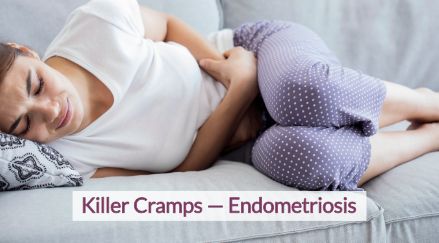March is Endometriosis Awareness Month
And that means it’s Endometriosis Awareness Month! According to the Endometriosis Research Center, Endometriosis affects more than 7 million women in the US and is the leading cause of female infertility. In most cases, this can be a very painful reproductive and immunological disease in which the endometrium, the uterine lining, moves outside of the uterus and implants in other areas of the pelvic region. It is often described as “killer cramps,” and endometriosis can affect any woman from adolescence to post-menopause.
Common Symptoms
Endometriosis can present the following symptoms:
- Very painful periods.
- Pelvic pain at any point during a woman’s or girl’s cycle.
- Heavy or irregular periods.
- Infertility.
- Pain with sexual activity, urination or bowel movements.
- Chronic lower back pain.
Interestingly, many women have no symptoms.
Treatments
Treating endometriosis begins with the patient’s symptoms and goals. Some women want to manage their pain while others are concerned about preserving their fertility. The treatments for women who plan to have a baby may be different from those whose chief complaint is the pain.
Some natural remedies:
- Acupuncture
- Herbal supplements
- Warm baths with Epsom salts
- Castor oil packs on the belly
- Avoiding hormonally-treated products
- Less red meat and more organic vegetables and fruit
- High doses of Omega 3 fatty acids
Additional Treatment Options:
Pain medication. For some women with mild symptoms, doctors may suggest taking over-the-counter medicines for pain. These include ibuprofen (Advil and Motrin) or naproxen (Aleve). When these medicines don’t help, doctors may prescribe stronger pain relievers.
Hormone treatment. When pain medicine is not enough, doctors often recommend hormones. Hormone treatment is best for women with small growths who do not have bad pain.
Birth control pills are used to decrease the amount of menstrual flow and prevent overgrowth of the tissue that lines the uterus. Once a woman stops taking them, she can get pregnant again. Stopping these pills will cause the symptoms of endometriosis to return.
GnRH agonists and antagonists greatly reduce the amount of estrogen in a woman’s body, which stops the menstrual cycle. These drugs cause side effects similar to menopause, such as hot flashes, bone loss, and vaginal dryness. The difficulties with endometriosis may disappear for months.
Surgery is usually the best choice for women with severe endometriosis including many growths, a great deal of pain, or fertility problems. Both minor and more complex surgeries can help.
Your doctor might suggest one of the following:
- Laparoscopy treatment can be used to diagnose and treat endometriosis. This procedure is the most common as it is less invasive. During this procedure, doctors remove growths and scar tissue or burn them away. The goal is to treat the endometriosis without harming the healthy tissue around it and to relieve pain. If the endometriosis is interfering with trying to get pregnant, often this procedure corrects this problem as well.
- Laparotomy is a major abdominal surgery involving a larger cut in the abdomen than with laparoscopy. This allows the doctor to reach and remove growths of endometriosis in the pelvis or abdomen.
- Hysterectomy is a surgery in which the doctor removes the uterus and sometimes the ovaries. This is done when the endometriosis has severely damaged these organs and should only be considered as the last resort.
Because endometriosis symptoms recur when treatment stops, many women have found other therapies to be very helpful in alleviating symptoms such as acupuncture, herbal remedies, aromatherapy, dietary modifications, vitamin supplements and relaxation techniques.
How Acupuncture Helps
Acupuncture involves the placing of very fine needles into the skin. This insertion stimulates the nervous system to release chemicals and hormones from our brain, such as neurotransmitters, prostaglandins, and endorphins, which create a biochemical change in the body.
When this takes place, pain and inflammation are reduced, circulation is increased, stress is reduced and physical and emotional well-being occurs. Research supports evidence that acupuncture is an effective treatment for endometriosis.
One study (published in the European Journal of Obstetrics & Gynecology and Reproductive Biology, 2010 Nov; 153(1):90-3. Epub 2010 Aug 21) confirmed that 86 percent of the women in the study had considerable results within 10 treatments of acupuncture.
AIM Wellness Center specializes in women’s reproductive disorders.
We have treated numerous women and adolescent girls who noticed a decrease in pain and an improvement in their menstrual cycle after one month of treatment. The treatment is usually twice a week for the first month, and then the person is reevaluated. Depending on the severity of the disease and the woman’s goals, it can take up to three to six months for significant results. Acupuncture is definitely an avenue that should be considered when dealing with endometriosis.
If you are experiencing pain or fertility challenges from Endometriosis, please contact us for a complimentary consultation to see how we can help: +1 (805) 497-2625




